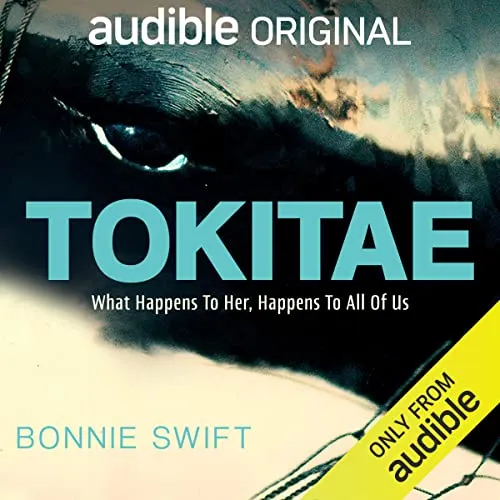The Daily sat down with Stanford alumna Bonnie Swift ’08 to discuss her first long-form audio story published on Audible about captive orca Tokitae, also known as Lolita and Sk’aliCh’elh-tenaut, and the decades-long fight to bring the killer whale back to the Salish Sea after more than 50 years of Tokitae living in the Miami Seaquarium.
On Aug. 8, 1970, Tokitae was one of seven juvenile orcas abducted from the islands north of Seattle. Multiple lawsuits were unsuccessful in moving Tokitae into a seaside sanctuary as her species faces risk of extinction. Swift’s eight-episode audio story documents the efforts to rescue her and delves deep into issues of environmentalism, extinction, indigenous rights, grief and spirituality.
The Stanford Daily [TSD]: For people who have never heard about Tokitae or listened to your audio story, how would you summarize the importance of your work and the story of this orca?
Bonnie Swift [BS]: This is a story about a captive killer whale, but it’s also a story about lots of other things — the failures of environmental law, the parallels between genocide and extinction, and how humans deal with pain, destruction, grief and beauty. My hope is that with our eyes open and our hearts full, we can start to turn some corners and repair some of the damage we’ve done to one another and the planet.
TSD: Your biography on your website mentions that you are a writer “dedicated to crafting compelling and insightful stories.” What made you want to pursue the story of Lolita and display it in audio form?
BS: My first exposure to radio and podcast was through the Stanford Storytelling Project, where I was trained by professor Jonah Willihnganz. In addition to giving his students and producers a solid foundation in the craft of oral narrative, Jonah subtly stresses the healing potential of storytelling. I graduated in 2008, and in the various projects and stories I’ve worked on since then, I’ve always been after transformation and healing. For me, that usually comes through insight.
TSD: Your work and passion for orcas span several decades. What was your motivation for doing this story?
BS: I happened to spend a good chunk of my childhood living on the cove where Tokitae was captured in 1970 in the islands just north of Seattle, so I grew up hearing the story of this whale, her capture, and her circumstances at the Miami Seaquarium. As a child, I was introduced to the campaign to bring her home, and sang songs at protest events on her behalf. In my 30s, I realized that Tokitae was still alive, and still living in Miami, and I knew I had to write a story about her and the decades-long campaign to bring her home.
TSD: Can you tell me a little bit about the process of recording and editing this audio story, and what challenges or surprises came along throughout the project?
BS: It took me almost three years to write and produce this story. For the first two years, it was a side project, but for the past year I’ve been working on it full time. With a documentary podcast like this, I usually start by making a rough outline of the story. Then I do interviews. Then I comb through my interviews and decide which quotes to put where. Then I write my own narration around the quotes.
It’s quite a sad story, but what surprised me most was that once I faced that sadness, what I actually discovered was something more akin to love.
TSD: Who did you collaborate with on this project, and how can people listen to it today?
BS: I had a team of about a dozen people. Much of the Tokitae story centers on a campaign led by members of the Lummi Nation, an indigenous people from the San Juan Islands, so I hired as many Lummi collaborators for this project as I could, including a musician and ceremonialist who contributed much of the original music and offered prayers for the story.
l also hired an editor, a fact checker, three production assistants, two lawyers, two more musicians, and a team of sound designers. I worked with an executive producer at Audible (also a Stanford Storytelling Project alum) and received various kinds of support from many other people at Audible.
You can listen to Tokitae on Audible or Amazon Prime.
TSD: What would you say are your long-term goals going forward with this project or topic?
BS: My secret wish for this story has always been that it might help bring Tokitae home to a seaside sanctuary in the Salish Sea. But my larger hope is that this story will help people feel like they are part of something much larger than themselves, or even humanity. Mythologist Martin Shaw calls it an “ancient love affair” or a “dream tangle” with nature.
TSD: What was the e of creating this audio story, and do you think that purpose was fulfilled?
BS: I’ve always wanted to produce a story like this, and I’m really grateful that Audible took it on, and that I had so much support from so many talented people. I hope I get to make another one!
This interview has been condensed and lightly edited for clarity.
This article has been updated to correctly describe the length of Swift’s advocacy efforts, clarify the intentions of Tokitae’s rescue efforts and accurately describe where Tokitae was captured. A previous version of this article also did not specify that Tokitae has three interchangeable names, incorrectly stated that Tokitae was among six rather than seven whales and incorrectly stated that Swift’s audio series had seven episodes rather than eight. The Daily regrets these errors.
